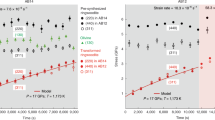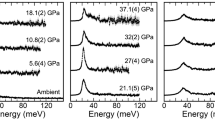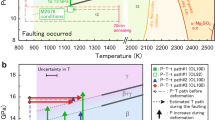Abstract
The relative motion of lithospheric plates and underlying mantle produces localized deformation near the lithosphere–asthenosphere boundary1. The transition from rheologically stronger lithosphere to weaker asthenosphere may result from a small amount of melt or water in the asthenosphere, reducing viscosity1,2,3. Either possibility may explain the seismic and electrical anomalies that extend to a depth of about 200 kilometres4,5. However, the effect of melt on the physical properties of deformed materials at upper-mantle conditions remains poorly constrained6. Here we present electrical anisotropy measurements at high temperatures and quasi-hydrostatic pressures of about three gigapascals on previously deformed olivine aggregates and sheared partially molten rocks. For all samples, electrical conductivity is highest when parallel to the direction of prior deformation. The conductivity of highly sheared olivine samples is ten times greater in the shear direction than for undeformed samples. At temperatures above 900 degrees Celsius, a deformed solid matrix with nearly isotropic melt distribution has an electrical anisotropy factor less than five. To obtain higher electrical anisotropy (up to a factor of 100), we propose an experimentally based model in which layers of sheared olivine are alternated with layers of sheared olivine plus MORB or of pure melt. Conductivities are up to 100 times greater in the shear direction than when perpendicular to the shear direction and reproduce stress-driven alignment of the melt. Our experimental results and the model reproduce mantle conductivity–depth profiles for melt-bearing geological contexts. The field data are best fitted by an electrically anisotropic asthenosphere overlain by an isotropic, high-conductivity lowermost lithosphere. The high conductivity could arise from partial melting associated with localized deformation resulting from differential plate velocities relative to the mantle, with subsequent upward melt percolation from the asthenosphere.
This is a preview of subscription content, access via your institution
Access options
Subscribe to this journal
Receive 51 print issues and online access
$199.00 per year
only $3.90 per issue
Buy this article
- Purchase on Springer Link
- Instant access to full article PDF
Prices may be subject to local taxes which are calculated during checkout




Similar content being viewed by others
References
Holtzman, B. K. & Kendall, J.-M. Organized melt, seismic anisotropy, and plate boundary lubrication. Geochem. Geophys. Geosyst. 11, Q0AB06 (2010).
Höink, T., Lenardic, A. & Richards, M. Depth-dependent viscosity and mantle stress amplification: implications for the role of the asthenosphere in maintaining plate tectonics. Geophys. J. Int. 191, 30–41 (2012).
Karato, S.-i. On the origin of the asthenosphere. Earth Planet. Sci. Lett. 321–322, 95–103 (2012).
Kawakatsu, H. et al. Seismic evidence for sharp lithosphere-asthenosphere boundaries of oceanic plates. Science 324, 499–502 (2009).
Naif, S., Key, K., Constable, S. & Evans, R. L. Melt-rich channel observed at the lithosphere–asthenosphere boundary. Nature 495, 356–359 (2013).
Hirschmann, M. M. Partial melt in the oceanic low velocity zone. Phys. Earth Planet. Inter. 179, 60–71 (2010).
Matsuno, T. et al. Upper mantle electrical resistivity structure beneath the central Mariana subduction system. Geochem. Geophys. Geosyst. 11, Q09003 (2010).
Baba, K., Chave, A. D., Evans, R. L., Hirth, G. & Mackie, R. L. Mantle dynamics beneath the East Pacific Rise at 17 °S: insights from the Mantle Electromagnetic and Tomography (MELT) experiment. J. Geophys. Res. 111, B02101 (2006).
Reynard, B., Mibe, K. & Van de Moortèle, B. Electrical conductivity of the serpentinised mantle and fluid flow in subduction zones. Earth Planet. Sci. Lett. 307, 387–394 (2011).
Yoshino, T., Takuya, M., Yamashita, S. & Katsura, T. Hydrous olivine unable to account for conductivity anomaly at the top of the asthenosphere. Nature 443, 973–976 (2006).
Poe, B. T., Romano, C., Nestola, F. & Smyth, J. R. Electrical conductivity anisotropy of dry and hydrous olivine at 8 GPa. Phys. Earth Planet. Inter. 181, 103–111 (2010).
Caricchi, L., Gaillard, F., Mecklenburgh, J. & Le Trong, E. Experimental determination of electrical conductivity during deformation of melt-bearing olivine aggregates: implications for electrical anisotropy in the oceanic low velocity zone. Earth Planet. Sci. Lett. 302, 81–94 (2011).
Zhang, B., Yoshino, T., Yamazaki, D., Manthilake, G. & Katsura, T. Electrical conductivity anisotropy in partially molten peridotite under shear deformation. Earth Planet. Sci. Lett. 405, 98–109 (2014).
Holtzman, B. K. et al. Melt segregation and strain partitioning: implications for seismic anisotropy and mantle flow. Science 301, 1227–1230 (2003).
King, D. S., Kohlstedt, D. L. & Zimmerman, M. E. Stress-driven melt segregation in partially molten rocks deformed in torsion. J. Petrol. 51, 21–42 (2010).
Parsons, R. A., Nimmo, F., Hustoft, J., Holtzman, B. K. & Kohlstedt, D. L. An experimental and numerical study of surface tension-driven melt flow. Earth Planet. Sci. Lett. 267, 548–557 (2008).
King, D. S. H., Hier-Majumder, S. & Kohlstedt, D. L. An experimental study of the effects of surface tension in homogenizing perturbations in melt fraction. Earth Planet. Sci. Lett. 307, 349–360 (2011).
Kohlstedt, D. L. & Zimmerman, M. E. Rheology of partially molten mantle rocks. Annu. Rev. Earth Planet. Sci. 24, 41–62 (1996).
Pommier, A., Gaillard, F., Pichavant, M. & Scaillet, B. Laboratory measurements of electrical conductivities of hydrous and dry Mount Vesuvius melts under pressure. J. Geophys. Res. 113, B05205 (2008).
Constable, S. SEO3: a new model of olivine electrical conductivity. Geophys. J. Int. 166, 435–437 (2006).
Jung, H., Katayama, I., Jiang, Z., Hiraga, T. & Karato, S. Effect of water and stress on the lattice-preferred orientation of olivine. Tectonophysics 421, 1–22 (2006).
Ni, H., Keppler, H. & Behrens, H. Electrical conductivity of hydrous basaltic melts: implications for partial melting in the upper mantle. Contrib. Mineral. Petrol. 162, 637–650 (2011).
Evans, R. L., Wannamaker, P. E., McGary, R. S. & Elsenbeck, J. Electrical structure of the central Cascadia subduction zone: the EMSLAB Lincoln Line revisited. Earth Planet. Sci. Lett. 402, 265–274 (2014).
Havlin, C., Parmentier, E. M. & Hirth, G. Dike propagation driven by melt accumulation at the lithosphere–asthenosphere boundary. Earth Planet. Sci. Lett. 376, 20–28 (2013).
Sakamaki, T. et al. Ponded melt at the boundary between the lithosphere and asthenosphere. Nature Geosci. 6, 1041–1044 (2013).
Dai, L., Li, H., Li, C., Hu, H. & Shan, S. The electrical conductivity of dry polycrystalline olivine compacts at high temperatures and pressures. Mineral. Mag. 74, 849–857 (2010).
Xu, Y. S., Shankland, T. J. & Duba, A. G. Pressure effect on electrical conductivity of mantle olivine. Phys. Earth Planet. Inter. 118, 149–161 (2000).
Roberts, J. J. & Tyburczy, J. A. Partial-melt electrical conductivity: influence of melt composition. J. Geophys. Res. 104, 7055–7065 (1999).
Yoshino, T., Laumonier, M., McIsaac, E. & Katsura, T. Electrical conductivity of basaltic and carbonatite melt-bearing peridotites at high pressures: implications for melt distribution and melt fraction in the upper mantle. Earth Planet. Sci. Lett. 295, 593–602 (2010).
Yoshino, T., McIsaac, E., Laumonier, M. & Katsura, T. Electrical conductivity of partial molten carbonate peridotite. Earth Planet. Sci. Lett. 194–195, 1–9 (2012).
Stagno, V. & Frost, D. Carbon speciation in the asthenosphere: experimental measurements of the redox conditions at which carbonate-bearing melts coexist with graphite or diamond in peridotite assemblages. Earth Planet. Sci. Lett. 300, 72–84 (2010).
King, D. S. H., Hier-Majumder, S. & Kohlstedt, D. L. An experimental study of the effects of surface tension in homogenizing perturbations in melt fraction. Earth Planet. Sci. Lett. 307, 349–360 (2011).
Pommier, A. Leinenweber, K. & Tasaka, M. Experimental investigation of the electrical behavior of olivine during partial melting under pressure and application to the lunar mantle. Earth Planet. Sci. Lett. (in the press).
Ni, H., Keppler, H., Manthilake, M. A. & Katsura, T. Electrical conductivity of dry and hydrous NaAlSi3O8 glasses and liquids at high pressures. Contrib. Mineral. Petrol. 162, 501–513 (2011).
Martí, A. The role of electrical anisotropy in magnetotelluric responses: from modelling and dimensionality analysis to inversion and interpretation. Surv. Geophys. 35, 179–218 (2014).
Acknowledgements
This work benefited from funding by the NSF through Cooperative Studies of the Earth’s Deep Interior (CSEDI) projects number 1461594 to the University of California San Diego, number 1265395 to Arizona State University, and number 1265428 to the University of Minnesota. This research was partially supported by COMPRES (the Consortium for Materials Properties Research in Earth Sciences) under National Science Foundation (NSF) Cooperative Agreement EAR 11-57758 (cell assembly development project). We thank A. von der Handt (University of Minnesota) and H. Cathey (Arizona State University) for their assistance with the electron microprobe and scanning electron microscope imaging, respectively. A.P. appreciates help with calibration experiments from staff and scientists at Bayerisches GeoInstitut (BGI). This paper is Lunar and Planetary Institute (LPI) contribution number 1840.
Author information
Authors and Affiliations
Contributions
A.P. proposed and led the project, performed the conductivity experiments and the electron microprobe analyses, interpreted the results, wrote the first draft and made the figures. K.L. and A.P. developed the conductivity setup at Arizona State University. D.L.K. and C.Q. synthesized the deformed starting materials and provided some of the scanning electron microscope images. E.J.G., S.J.M. and D.L.K. contributed to the data interpretation and discussion. All authors commented on the manuscript and provided editorial assistance.
Corresponding author
Ethics declarations
Competing interests
The authors declare no competing financial interests.
Extended data figures and tables
Extended Data Figure 1 Experimental protocol.
a, Starting material preparation. Deformed material is synthesized in a gas-medium apparatus at 300 MPa (left), and its outer part is extracted for electrical measurements in the multi-anvil apparatus at about 3 GPa (right). Two orientations of the sample are considered, leading to vertical (blue) and tangential (purple) electrical measurements. b, Cross-section of the electrical conductivity cell (14/8 multi-anvil assembly, that is, the corner-truncation edge length is 8 mm and the pressure media edge length is 14 mm). Both electrodes are made of W–Re thermocouple wire with one electrode also serving as a thermocouple. c, Example of a complex impedance spectrum (real part Z′ versus imaginary part Z′′) for a sheared sample of olivine + 5 vol% MORB sample at 750 °C and approximately 3 GPa. The intersection between the response of the sample (blue dots, each dot corresponding to one frequency) with the real axis corresponds to the electrical resistance of the sample. The corresponding electrical conductivity value is obtained using the geometric factor (the surface of the electrode divided by thickness of the sample).
Extended Data Figure 2 Texture and melt geometry.
a, Back-scattered electron image of sheared sample PT0683-2 after electrical measurements, showing that deformation-induced melt texture was preserved during the experiment in the multi-anvil apparatus. b, Back-scattered electron image of sheared sample PT0756-2 after electrical measurements, illustrating the location of melt amongst the olivine grains. c, Starting material PT0683 showing the presence of melt-rich bands. d, Back-scattered electron image of sheared sample PT0683-1HT after electrical measurements at high temperature (up to 1,573 K). The absence of pronounced melt-rich bands suggests a loss in structural anisotropy, attributed to the effect of high temperature. These observations are consistent with electrical data that showed a noticeable decrease in electrical anisotropy with increasing temperature. e, Back-scattered electron image of sheared sample PT0683-1LT after electrical measurements at low temperature (<1,073 K), showing several light-coloured zones identified as melt-rich bands. The rectangle corresponds to the location of image f below. f, Zoom on melt-rich bands in sample PT0683-1LT. Melt is also present between the melt-rich zones as pockets amongst the olivine grains. g, Map of sodium distribution in sample PT0742-2 after electrical measurements. Colours correspond to the number of counts. Warm colours (reddish) correspond to high sodium concentration and are interpreted as pockets of carbonatite melt between olivine grains.
Rights and permissions
About this article
Cite this article
Pommier, A., Leinenweber, K., Kohlstedt, D. et al. Experimental constraints on the electrical anisotropy of the lithosphere–asthenosphere system. Nature 522, 202–206 (2015). https://doi.org/10.1038/nature14502
Received:
Accepted:
Published:
Issue Date:
DOI: https://doi.org/10.1038/nature14502
This article is cited by
-
Electrical conductivity measurements in piston cylinder press: metal shielding in the assembly design and implications
Contributions to Mineralogy and Petrology (2023)
-
The mantle structure below petit-spot volcanoes
Communications Earth & Environment (2022)
-
Electrical Conductivity of Eclogite, Amphibolite and Garnet-Quartz-Mica Schist with Implications for the Conductivity in the Qiangtang Terrane of Northern Tibetan Plateau
Journal of Earth Science (2020)
-
Some remarks on hydrogen-assisted electrical conductivity in olivine and other minerals
Progress in Earth and Planetary Science (2019)
-
Simultaneous measurements of electrical conductivity and seismic wave velocity of partially molten geological materials: effect of evolving melt texture
Physics and Chemistry of Minerals (2019)
Comments
By submitting a comment you agree to abide by our Terms and Community Guidelines. If you find something abusive or that does not comply with our terms or guidelines please flag it as inappropriate.



